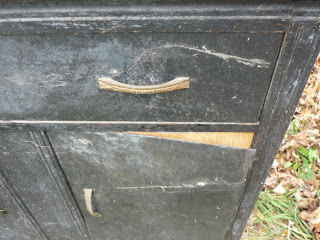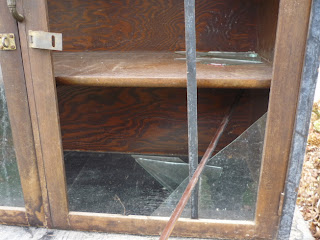So, I'm going to jump ahead of our MAJOR project of replacing the flooring and floor joists-remember what I said about foundation issues-and land here with building a natural lake stone hearth for our new wood stove. We put a beautiful Lopi Republic 1750 in to help heat the place, and to add romance to our living room. I always wanted a wood fireplace, but I'm more than happy with the stove!
We had a lot of options for a hearth pad. We could buy a premade one, or make one from tile or store bought materials. However, in the spirit of living lakeside as well as in the interest of being frugal (we won't say cheap, lol) we decided to take advantage of our own resources. Granted, we would need to buy the mortor and grout, but we could make it whatever size and shape we wanted AND save $$ on material costs vs buying tile, etc. Also, it would feel more connected to the location by using materials from our own front yard.
We built it bigger (about 6' long by 4' deep) than needed for clearances, to give us a raised place for wood storage. The base pad is simply 2x4's built in a square (there are two additional 2x4's inside of the square for support) and covered in Durarock.
We started by picking a LOT of relatively flat rocks and setting them out on the Durarock to get an idea of pattern and to see if we wanted larger or smaller rocks (the picture below shows the small ones on the left and the larger ones on the right). If you are building your own hearth pad, be sure to check your local building codes and the stove manufacturer's guidelines for clearances. We chose the Republic because it has a VERY close rear clearance (4" from back of stove to combustibles with a double wall pipe), and even though our living room isn't small, it isn't large either so we wanted to take up as little floor space as possible with the pad.

Once we had an idea of the layout, we set the stones using a mortor made for natual stone (there are different types, depending on how porous your material is). It wasn't really that bad once we got going, although getting it out of the bucket with the notched trowel was a bit of a pain, so I used a paint stick. What we did was get a pattern laid out for a general idea, then we took all of them off the pad. I know it sounds like extra work, but we wanted the basic plan laid out-did we want all bigger stones, all smaller stones, or a mix? We chose a mix. It would have been nearly impossible to lay them back in the same pattern, so it was just easier to take them all back off. Then we worked in 2' x 2' areas, toweling on the mortor with the notched trowel, then laying the stones into that. We did "butter" (put some extra mortor on the back side) some of the stones as well. I'd say this process took a few hours, and I was the only one laying them, to avoid two different patterns emerging (like certain painting techniques, everyone has a slightly different method of laying the stones). We then allowed the mortor dry for 3 days, per the instructions.

After all the stones were set in the mortor, we leaned a few pieces of our "reclaimed" paneling up against the wall to see how it would look. I am in LOVE with the paneling. I'll blog about that later, it's a take on white washing and pickling on natural pine, and it was done not only to lighten the room, but because we didn't have enough of the old paneling after doing some work in the room. It's done to resemble chippy, worn barn wood siding. There is an old barn we pass every day which has weathered white siding and it really reminds me of that.

Once the mortor was dry, we sealed and then grouted the stones. The sealing was simple-just paint on the sealer with a brush. This step was supposed to prevent the grout color staining the stones, and it did for the most part. Grouting still took TEN hours, even after sealing the stones!! Typically it wouldn't take this long to grout I'm sure, but because the stones are so porous each stone had to be "scrubbed" to remove the grout from them, then the grout had to be finished (I used damp rags for this). To grout, I used a rubber grout float that had some "give" and fit to the natural contours of the stones. We used a lighter grey grout called "Delorean gray" (yes, like the car from Back to The Future). Then we fitted the paneling in around the hearth pad after the grout dried (please excuse the "orbs" in the photo-there's still a good bit of construction dust floating about).

Once the grout was dry, we got the stove installed, and put a neat vintage crate next to it as a wood box. I *LOVE* old crates. If you follow along, you'll see them in other places too. The brass fireplace tools are also vintage. We picked up the crate for $2 at a garage sale before the whole crate frenzy took hold, and the tools were bought from an architectural salvage company many years ago (they used to sit next to our gas stove at our old house for that "real" look) for $20. We had the fireplace distributor install the stove, that was one of the few things we decided not to DIY.
We still have to finish the sides, but we're waiting to do that until we have the floors in. That will be a while, we've been using the sliding doors to bring in materials, so we figured we'd leave that until the end to avoid doing too much damage to them.










